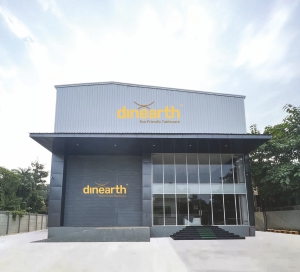
Dinearth (Ashtavinayak Industries) was established by Abhinav Group of Industries to contribute towards sustainable practices in India. Today, the brand is known for its biodegradable high-quality tableware and packaging solutions. Mr. Harsh Mehta, Director, shared with Paper Mart how Dinearth uses bagasse-based pulp to manufacture its product line. He also shared the company’s history, vision, manufacturing capacity and process, and product line.
Company’s Overview
Dinearth, a brand of Abhinav Group of Industries, started its manufacturing process in 2018. The company started with a small production facility to test the market, and after a few months of production they realised the huge potential of the industry. Since then, the company’s production has grown to 8 times and today it is among India’s largest bagasse tableware manufacturing companies. The monthly production of Dinearth is 500 tons, that is 6,000 TPA. The company has major market share in India alongwith exports. The company exports 60 percent of its existing products to 30+ countries. The major clientele of the company includes big QSR restaurants, like McDonalds, KFC, Burger King, Chaayos, etc.
Watch: JMC Paper Tech Launches New Subsidiary JMC Papers

Manufacturing Operations & Product Line
Dinearth puts bagasse, that is sugarcane waste, through the hydra pulping process, which is followed by beating the pulp process in the pulp tank. Thermoforming of plates is followed by heating the formed product and then trimming is done on the products. After performing a thorough quality check the final products are packaged and eventually dispatched according to the orders. The company uses two factories to produce 6,000 TPA of finished products.
Mr. Mehta elaborated on the brand’s product line, “We have the largest biodegradable tableware product line in India. We have a multiple category of products, such as bowls, plates, compartment plates, trays, containers, clamshell boxes, take away containers, lids, paper straws, etc.” The company offers round plates in 6-12 inches diameter, compartment plates ranging from minimum 3 to maximum 9 compartments, multipurpose trays with/without compartments (depending on their application), bowls ranging from 100-150 ml and 12 & 16 oz, 340 & 500 ml lid-containers, campshell containers in varying quantities and dimensions, and paper straws in different colours and patterns ranging from 5-12 mm sizes.
“As per our market study, the overall market size of this category product is 60,000 TPA, hence, there is a huge potential of growth in this industry and in the coming time it will grow in a sustainable way.”
Trends In Biodegradable Tableware Market
Market trends are favorable for the industry as the government is taking all the necessary steps for more public awareness to stop using plastic disposable tableware products, and switch to available eco-friendly disposable options. “As per our market study, the overall market size of this category product is 60,000 TPA, hence, there is a huge potential of growth in this industry and in the coming time it will grow in a sustainable way,” commented Mr. Mehta on the demand of biodegradable tableware in the market. At some level bagasse tableware has taken over the market, but still, there are little difficulties in establishing good sales, because plastic tableware is still prominently available in the market.
Also Read: CHUK, Yash Pakka Plans to Ramp Up Biodegradable Tableware
Elaborating on Dinearth’s plans to tap the mentioned market, he further shared, “We have a very aggressive growth plan in place for the coming years. At the end of last year, we opened our third manufacturing facility for bagasse tableware, which is now fully operational to cater to domestic as well as international demand of the market. We keep introducing new, innovative, and sustainable products in the marketplace. Our goal is to replace styrofoam products with our biodegradable tableware products and become Asia’s largest manufacturing company for bagasse-based tableware.”



